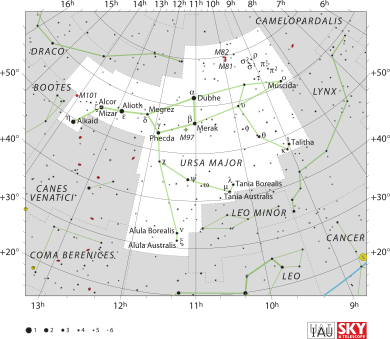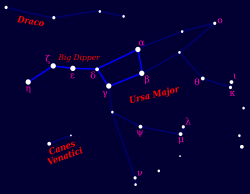Ursa Major facts for kids
| Constellation | |

List of stars in Ursa Major
|
|
| Abbreviation | UMa |
|---|---|
| Genitive | Ursae Majoris |
| Pronunciation | genitive |
| Symbolism | the Great Bear |
| Right ascension | 10.67 |
| Declination | +55.38 |
| Quadrant | NQ2 |
| Area | 1280 sq. deg. (3rd) |
| Main stars | 7, 20 |
| Bayer/Flamsteed stars |
93 |
| Stars with planets | 20 |
| Stars brighter than 3.00m | 7 |
| Stars within 10.00 pc (32.62 ly) | 8 |
| Brightest star | ε UMa (Alioth) (1.76m) |
| Messier objects | 7 |
| Meteor showers | Alpha Ursa Majorids Leonids-Ursids |
| Bordering constellations |
Draco Camelopardalis Lynx Leo Minor Leo Coma Berenices Canes Venatici Boötes |
| Visible at latitudes between +90° and −30°. Best visible at 21:00 (9 p.m.) during the month of April. The Big Dipper or Plough. |
|
Ursa Major is a constellation that can be seen in the northern hemisphere and part of the southern hemisphere. Its name means Great Bear in Latin. It was named that because many different groups of people around the world have thought that its stars look a lot like a bear with a long tail. It is often used as a symbol for north.
Contents
Deep-sky objects
Several bright galaxies are found in Ursa Major, including the pair Messier 81 (one of the brightest galaxies in the sky) and Messier 82 above the bear's head, and the Pinwheel galaxy (M101), a beautiful spiral galaxy northwest of the star η Ursae Majoris. Other well-known spiral galaxies are NGC 4102, NGC 4605, Messier 108 and Messier 109. The constellation has about 50 galaxies that can be seen with a small telescope. The Owl nebula, the brightest planetary nebula, can be found along the bottom of the bowl of the Big Dipper.
The Big Dipper
The seven stars in the upper-left corner of Ursa Major form an asterism called the Big Dipper (or the Plough in Great Britain). This group has been recognized by almost all groups of people who live or lived in places where it can be seen in the sky and it is one of the best-known star patterns. The Big Dipper is helpful in finding the north star because an imaginary line drawn through the two stars on the right side will point directly at the north star. These two stars are called The Pointers and they are very important on navigation by stars.
All of the stars in the Big Dipper except Dubhe and Alkaid are moving toward the same point in the sky through proper motion. This group of stars is known as the Ursa Major Moving Group.
Mythology
The constellation of Ursa Major has been seen as a bear, usually female, by many distinct civilizations. This may stem from a common oral tradition of Cosmic Hunt myths stretching back more than 13,000 years.
Greco-Roman tradition
In Greek mythology, Zeus (the king of the gods, known as Jupiter in Roman mythology), courts young woman named Callisto, a nymph of Artemis (known to the Romans as Diana). Zeus's jealous wife Hera, (Juno to the Romans), discovers that Callisto gives birth to Zues' son named Arcas and transforms Callisto into a bear as a punishment. Callisto, while in bear form, later encounters her son Arcas. Arcas almost spears the bear, but to avert the tragedy Zeus whisks them both into the sky, Callisto as Ursa Major and Arcas as the constellation Boötes. Ovid called Ursa Major the Parrhasian Bear, since Callisto came from Parrhasia in Arcadia, where the story is set.
The Greek poet Aratus called the constellation Helike, ("turning" or "twisting"), because it turns around the celestial pole. The Odyssey notes that it is the sole constellation that never sinks below the horizon and "bathes in the Ocean's waves", so it is used as a celestial reference point for navigation. It has also been called the "Wain" or "Plaustrum", a Latin word referring to a horse-drawn cart.
Hindu tradition
In Hinduism, Ursa Major/Big dipper/ Great Bear is known as Saptarshi, each of the stars representing one of the Saptarishis or Seven Sages (Rishis) viz. Bhrigu, Atri, Angiras, Vasishtha, Pulastya, Pulaha, and Kratu. The fact that the two front stars of the constellations point to the pole star is explained as the boon given to the boy sage Dhruva by Lord Vishnu.
Judeo-Christian tradition
One of the few star groups mentioned in the Bible (Job 9:9; 38:32; – Orion and the Pleiades being others), Ursa Major was also pictured as a bear by the Jewish peoples. "The Bear" was translated as "Arcturus" in the Vulgate and it persisted in the King James Version of the Bible.
East Asian traditions
In China and Japan, the Big Dipper is called the "North Dipper" 北斗 (Chinese: běidǒu, Japanese: hokuto), and in ancient times, each one of the seven stars had a specific name, often coming themselves from ancient China:
-
- "Pivot" 樞 (C: shū J: sū) is for Dubhe (Alpha Ursae Majoris)
- "Beautiful jade" 璇 (C: xuán J: sen) is for Merak (Beta Ursae Majoris)
- "Pearl" 璣 (C: jī J: ki) is for Phecda (Gamma Ursae Majoris)
- "Balance" 權 (C: quán J: ken) is for Megrez (Delta Ursae Majoris)
- "Measuring rod of jade" 玉衡 (C: yùhéng J: gyokkō) is for Alioth (Epsilon Ursae Majoris)
- "Opening of the Yang" 開陽 (C: kāiyáng J: kaiyō) is for Mizar (Zeta Ursae Majoris)
- Alkaid (Eta Ursae Majoris) has several nicknames: "Sword" 劍 (C: jiàn J: ken) (short form from "End of the sword" 劍先 (C: jiàn xiān J: ken saki)), "Flickering light" 搖光 (C: yáoguāng J: yōkō), or again "Star of military defeat" 破軍星 (C: pójūn xīng J: hagun sei), because travel in the direction of this star was regarded as bad luck for an army.
In Shinto, the seven largest stars of Ursa Major belong to Ame-no-Minakanushi, the oldest and most powerful of all kami.
In South Korea, the constellation is referred to as "the seven stars of the north". In the related myth, a widow with seven sons found comfort with a widower, but to get to his house required crossing a stream. The seven sons, sympathetic to their mother, placed stepping stones in the river. Their mother, not knowing who put the stones in place, blessed them and, when they died, they became the constellation.
Native American traditions
The Iroquois interpreted Alioth, Mizar, and Alkaid as three hunters pursuing the Great Bear. According to one version of their myth, the first hunter (Alioth) is carrying a bow and arrow to strike down the bear. The second hunter (Mizar) carries a large pot – the star Alcor – on his shoulder in which to cook the bear while the third hunter (Alkaid) hauls a pile of firewood to light a fire beneath the pot.
The Lakota people call the constellation Wičhákhiyuhapi, or "Great Bear".
The Wampanoag people (Algonquian) referred to Ursa Major as "maske", meaning "bear" according to Thomas Morton in The New England Canaan.
The Wasco-Wishram Native Americans interpreted the constellation as 5 wolves and 2 bears that were left in the sky by Coyote.
Germanic traditions
To Norse pagans, the Big Dipper was known as Óðins vagn, "Woden's wagon". Likewise Woden is poetically referred to by Kennings such as vagna verr 'guardian of the wagon' or vagna rúni 'confidant of the wagon'
Uralic traditions
In the Finnish language, the asterism is sometimes called by its old Finnish name, Otava. The meaning of the name has been almost forgotten in Modern Finnish; it means a salmon weir. Ancient Finns believed the bear (Ursus arctos) was lowered to earth in a golden basket off the Ursa Major, and when a bear was killed, its head was positioned on a tree to allow the bear's spirit to return to Ursa Major.
In the Sámi languages of Northern Europe, part of the constellation (i.e. the Big Dipper minus Dubhe and Merak, is identified as the bow of the great hunter Fávdna (the star Arcturus). In the main Sámi language, North Sámi it is called Fávdnadávgi ("Fávdna's Bow") or simply dávggát ("the Bow"). The constellation features prominently in the Sámi national anthem, which begins with the words Guhkkin davvin dávggaid vuolde sabmá suolggai Sámieanan, which translates to "Far to the north, under the Bow, the Land of the Sámi slowly comes into view." The Bow is an important part of the Sámi traditional narrative about the night sky, in which various hunters try to chase down Sarva, the Great Reindeer, a large constellation that takes up almost half the sky. According to the legend, Fávdna stands ready to fire his Bow every night but hesitates because he might hit Stella Polaris, known as Boahji ("the Rivet"), which would cause the sky to collapse and end the world.
Southeast Asian traditions
In Burmese, Pucwan Tārā (ပုဇွန် တာရာ, pronounced "bazun taya") is the name of a constellation comprising stars from the head and forelegs of Ursa Major; pucwan (ပုဇွန်) is a general term for a crustacean, such as prawn, shrimp, crab, lobster, etc.
In Javanese, it is known as "lintang jong", which means "the jong constellation". Likewise, in Malay it is called "bintang jong".
Graphic visualisation
In European star charts, the constellation was visualized with the 'square' of the Big Dipper forming the bear's body and the chain of stars forming the Dipper's "handle" as a long tail. However, bears do not have long tails, and Jewish astronomers considered Alioth, Mizar, and Alkaid instead to be three cubs following their mother, while the Native Americans saw them as three hunters.
Noted children's book author H. A. Rey, in his 1952 book The Stars: A New Way to See Them, (ISBN: 0-395-24830-2) had a different asterism in mind for Ursa Major, that instead had the "bear" image of the constellation oriented with Alkaid as the tip of the bear's nose, and the "handle" of the Big Dipper part of the constellation forming the outline of the top of the bear's head and neck, rearwards to the shoulder, potentially giving it the longer head and neck of a polar bear.
-
Johannes Hevelius drew Ursa Major as if being viewed from outside the celestial sphere.
-
Starry Night Over the Rhone by Vincent van Gogh (1888)
Ursa Major is also pictured as the Starry Plough, the Irish flag of Labour, adopted by James Connolly's Irish Citizen Army in 1916, which shows the constellation on a blue background; on the state flag of Alaska; and on the House of Bernadotte's variation of the coat of arms of Sweden. The seven stars on a red background of the flag of the Community of Madrid, Spain, may be the stars of the Plough asterism (or of Ursa Minor). The same can be said of the seven stars pictured in the bordure azure of the coat of arms of Madrid, capital of that country.
Images for kids
-
Ursa Major shown on a carved stone, c.1700, Crail, Fife
See also
 In Spanish: Osa Mayor para niños
In Spanish: Osa Mayor para niños











